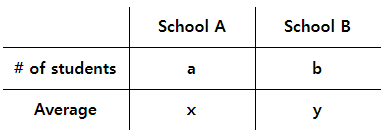[GMAT math practice question]
(statistics) 160 students from School A and School B are chosen to take the mathematics test and the average of the test is 66.5. How many students from School A are chosen?
1) The average of School A is 1.5 points higher than the total average.
2) The average of School B is 2.5 points lower than the total average.
=>
Forget conventional ways of solving math questions. For DS problems, the VA (Variable Approach) method is the quickest and easiest way to find the answer without actually solving the problem. Remember that equal numbers of variables and independent equations ensure a solution.
Visit
https://www.mathrevolution.com/gmat/lesson for details.
The first step of the VA (Variable Approach) method is to modify the original condition and the question. We then recheck the question. We should simplify conditions if necessary.
We assume that a and b are the numbers of students in School A and School B, and x and y are the average scores of Schools A and B, respectively.
Attachment:
 12.9DS(A).png [ 2.87 KiB | Viewed 1373 times ]
12.9DS(A).png [ 2.87 KiB | Viewed 1373 times ]
a + b = 160
Their average is (ax + by) / (a + b) = (ax + by) / 160 = 66.5 and it is equivalent to ax + by = 10640.
The question asks for the value of a.
Since we have 4 variables and 2 equations, C is most likely the answer. So, we should consider conditions 1) & 2) together first. After comparing the number of variables and the number of equations, we can save time by considering conditions 1) & 2) together first.
Conditions 1) & 2)
We have x = 66.5 + 1.5 = 68 from condition 1).
We have y = 66.5 - 2.5 = 64 from condition 2).
Then we have 68a + 64b = 10640.
Since we have a + b = 160, which we can multiply by 64 to get 64a + 64b = 64*160 = 10240.
Then we can say 4a = (68a + 64b) - (64a + 64b) = 10640 - 10240 = 400 or a = 100.
Therefore, both conditions together are sufficient.
Since this question is a statistics question (one of the key question areas), CMT (Common Mistake Type) 4(A) of the VA (Variable Approach) method tells us that we should also check answers A and B.
Condition 1)
We have x = 66.5 + 1.5 = 68 from condition 1).
The original condition tells us that a + b = 160 and ax + by = 10640.
a = 100, b = 60, x = 68 and y = 64 and a = 120, b = 40, x = 68, y = 62 are solutions.
Since condition 1) does not yield a unique solution, it is not sufficient.
Condition 2)
We have y = 66.5 - 2.5 = 64 from condition 2).
The original condition tells us that a + b = 160 and ax + by = 10640.
a = 100, b = 60, x = 68 and y = 64 and a = 64, b = 96, x = 70.25, y = 64 are solutions.
Since condition 2) does not yield a unique solution, it is not sufficient.
Therefore, C is the answer.
Answer: C
Normally, in problems which require 2 equations, such as those in which the original conditions include 2 variables, or 3 variables and 1 equation, or 4 variables and 2 equations, each of conditions 1) and 2) provide an additional equation. In these problems, the two key possibilities are that C is the answer (with probability 70%), and E is the answer (with probability 25%). Thus, there is only a 5% chance that A, B, or D is the answer. This occurs in common mistake types 3 and 4. Since C (both conditions together are sufficient) is the most likely answer, we save time by first checking whether conditions 1) and 2) are sufficient, when taken together. Obviously, there may be cases in which the answer is A, B, D, or E, but if conditions 1) and 2) are NOT sufficient when taken together, the answer must be E.

